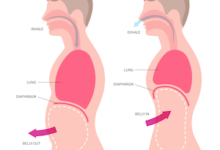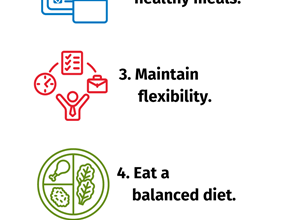PPE-Related Skin Complications and “Maskne” – What You Can Do to Prevent and Treat It
Page reviewed and updated: August 2023
We’re hiding behind masks these days and for all the right reasons: to protect ourselves and to protect others from infectious diseases. Health care professionals are required to wear masks and personal protective equipment (PPE) for prolonged periods of time, often for their entire shift whether it’s 8 hours, 12 hours or more. This extended use practice was employed during the COVID-19 pandemic to conserve the supply of PPE (Centers for Disease Control and Prevention [CDC], 2020). Today, clinicians continue to wear PPE for long hours which places them at high risk for developing skin complications such as face mask dermatitis, also known as irritant contact dermatitis. Symptoms will manifest as dryness, peeling, mild erythema, rashes, swelling, inflammatory pustules, maceration and skin breakdown on the nasal bridge, forehead, cheeks and behind the ears (Kelechi, Brunette & Lee, 2020).
Pacis, Azor-Ocampo, Burnett, Tanasapphaisal & Coleman (2020) conducted a quality improvement program to assess the use of prophylactic dressings to prevent skin breakdown when using N95 respirators. They assessed six different types of dressings that were designed to protect the skin from friction, pressure, or moisture; comfortable to wear; and easy to apply and remove without aerosolizing particles that could cause self-contamination. The only dressing that met all these criteria was the Adapt No Sting Skin Protective Wipe, an alcohol-free liquid acrylate dressing. The researchers found that applying this product to areas of friction before putting on the N95 respiratory mask will provide comfort, prevent skin friction, and maintain an adequate seal. Use of topical dressings with padding (i.e., foam, hydrocolloid) should be avoided with tight-fitting respirators as they may affect the fit and seal and reduce its effectiveness (Wound, Ostomy and Continence Nurses Society [WOCN] Board of Directors Task Force, 2020). You may use padded dressings under face shields that don’t require a seal against the skin if it does not compromise mask functionality (Kelechi, Brunette & Lee, 2020).
Preventing and Treating PPE-Related Skin Injuries
Several strategies to prevent and treat PPE-related skin injuries specifically for health care professionals are outlined below (Kelechi, Brunette & Lee, 2020; WOCN Board of Directors Task Force, 2020).
Prevention strategies include:
- Wash your face with a gentle face wash prior to applying the mask, and be sure to dry well.
- Apply a thin moisturizing facial lotion to the entire face.
- Use a noncomedogenic product if you are prone to acne.
- Use an alcohol-free barrier film (cyanoacrylate-based moisture barrier) if you tend to sweat or develop excessive moisture.
- Apply where the facepiece is likely to touch the skin or cause friction such as the nose bridge, cheeks, tops of ears, or forehead; avoid the eye area.
- Allow the products to dry for at least 90 seconds prior to putting on your mask.
- Barrier films do not need to be removed.
- Apply daily but decrease use if buildup occurs.
- Avoid petrolatum-based products as these may affect the seal of the mask; these products may be applied to broken skin when not wearing a mask.
- Watch for allergic reactions to the following materials:
- Glue strips or rubber along the nosepiece
- Metal wire, sometimes made of nickel
- Sterilizing sprays that are applied to reuse masks
Treatment strategies include:
- If contact dermatitis develops, a low-potency topical corticosteroid should be applied to decrease skin inflammation.
- For skin loss, apply a breathable, no-sting cyanoacrylate-based skin protectant/sealant up to 3 times per day.
Maskne
The COVID-19 pandemic has resulted in an increase in mask-associated acne and the birth of a new term: “maskne.” Maskne is a form of “facial dermatosis that occurs in areas of friction from the use of masks, respirators, and PPE” (Sinha & Singh, 2020). According to Teo (2020), maskne is likely due to follicular occlusion and directly related to mechanical stress such as pressure, occlusion, or friction, also known as acne mechanica, and changes in the skin microbiome including heat, pH, and moisture. Contributing factors include a genetic predisposition, older age, prior skin issues, long hours of PPE use, improper PPE sizing, tighter PPE and use of adhesive tape (Sinha & Singh, 2020).
The American Academy of Dermatology Association ([ADA], 2021), recommends several tips to help prevent maskne not only for health care professionals but for the general population:
- Cleanse and moisturize daily.
- Cleanse with an antibacterial, mild, fragrance-free cleanser.
- Moisturizers add a protective layer and decrease dryness.
- Look for moisturizers that include ceramides, hyaluronic acid, dimethicone.
- Apply before and after wearing a mask.
- Apply petroleum jelly to your lips after washing your face, before you put on your mask, and before bedtime.
- Avoid wearing makeup under your mask.
- If makeup is necessary, use products that are non-comedogenic and that won’t clog pores.
- Avoid new skin care products that can be irritating to your skin, such as chemical peels, exfoliants or retinoids for the first time.
- Decrease use of certain skin care products if your skin becomes irritated, such as leave-on salicylic acid, retinoid, or aftershave.
- Choose masks that (Teo, 2020):
- Are comfortable, with a snug fit.
- Have smooth surfaces without folds.
- Have a minimum of two layers of fabric.
- Are made of natural, breathable UPF 40+ fabrics such as cotton.
- Include adjustable ear loops.
- Don’t have metallic parts at nose bridge.
- Take a 15-minute break from your mask every 4 hours.
- Wash your fabric masks after each use.
Hydration and a daily skin care routine are both important components that help maintain healthy skin. As health care professionals, we often neglect our own needs to care for others. Take care of yourself – and your skin.
References:
American Academy of Dermatology Association (ND). 9 ways to prevent face mask skin problems. Retrieved January 11, 2021, from https://www.aad.org/public/everyday-care/skin-care-secrets/face/prevent-face-mask-skin-problems
Centers for Disease Control and Prevention (2020). Coronavirus disease 2019 (COVID-19) strategies for optimizing the supply of N95 respirators. Retrieved January 14, 2021 from https://www.cdc.gov/coronavirus/2019-ncov/hcp/respirators-strategy/index.html
Kelechi, T.J., Brunette, G. & Lee, L.W. (2020). Personal protective equipment-related equipment dermatitis. Journal of Wound, Ostomy and Continence Nursing. 47(4), 324-325. https://www.doi.org/10.1097/WON.0000000000000673
Pacis, M., Azor-Ocampo, A., Burnett, E., Tanasapphaisal, C., & Coleman, B. (2020). Prophylactic dressings for maintaining skin integrity of healthcare workers when using N95 respirators while preventing contamination due to the novel coronavirus, a quality improvement project. Journal of Wound, Ostomy and Continence Nursing, 47(6), 551-557. https://www.doi.org/10.1097/WON.0000000000000713
Sinha, A. & Singh, A.R. (2020). An unforeseen hazard of masks being in vogue. International Journal of Occupational and Environmental Medicine, 11, 213-214. https://www.doi.org/10.34172/ijoem.2020.2211
Teo, W. (2021). Diagnostic and management considerations for “maskne” in the era of COVID-19. Journal of the American Academy of Dermatology, 84(2), 520-521. https://doi.org/10.1016/j.jaad.2020.09.063
Wound, Ostomy and Continence Society (WOCN) Board of Directors Task Force. (2020). Guidance for maintaining skin health when utilizing protective masks for prolonged time intervals. Journal of Wound, Ostomy and Continence Nursing, 47(4), 317-318. https://www.doi.org/10.1097/WON.0000000000000677
More Reading and Resources






